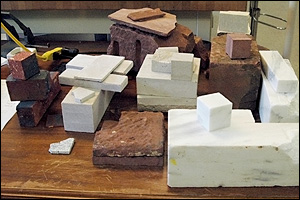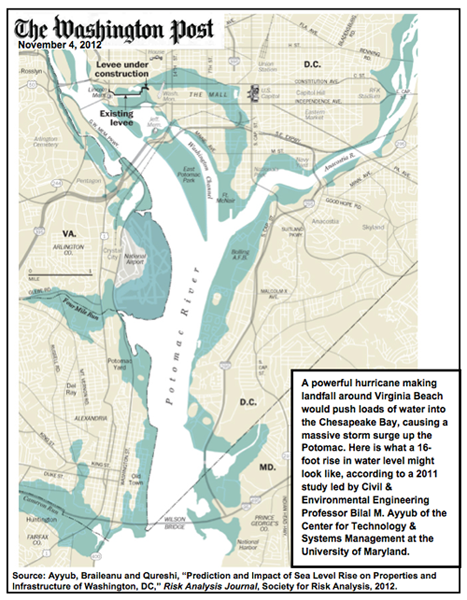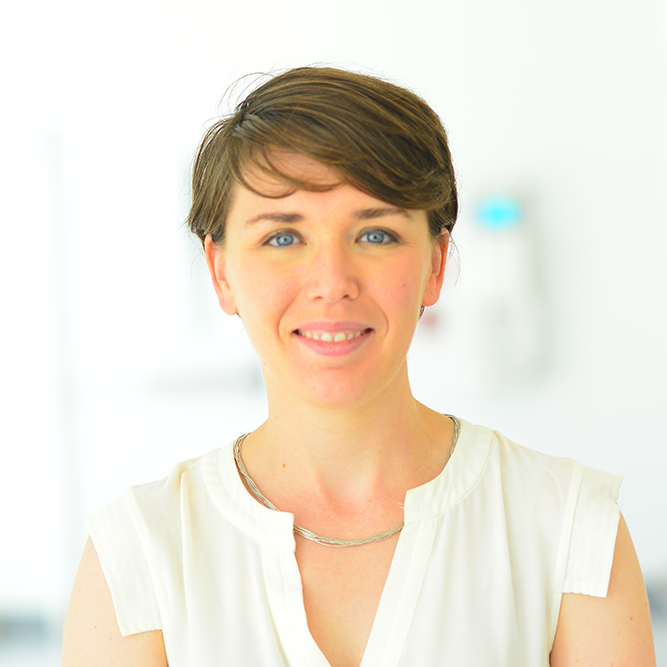News Story
Protecting Cultural Heritage

An assortment of stones and brick used in Smithsonian buildings, as well as masonry from the National Cathedral, the Arlington Cemetery Amphitheater, and the Jefferson Memorial, at the Smithsonian Institution's Museum Conservation Institute. The material will be used to make test samples with controlled properties. These will in turn be used to calibrate a new device capable of assessing buildings, monuments and artifacts in danger of deterioration from the effects of moisture. Photo courtesy of Emily Aloiz, Museum Conservation Institute.
The Clark School's Department of Materials Science and Engineering (MSE) is teaming up with the Smithsonian Institution's Museum Conservation Institute (MCI) for a feasibility study of a device that could be used to assess buildings, monuments and artifacts in danger of deterioration from the effects of moisture.
Professor Mohamad Al-Sheikhly and Adjunct Professor Richard Livingston are working on the yearlong project, funded by a UMD/Smithsonian Seed Grant, to develop a portable prototype system that uses prompt gamma neutron activation (PGNA) for the nondestructive measurement of moisture in porous construction materials such as brick, sandstone, and marble. The professors are partnering with Smithsonian Senior Objects Conservator Carol A. Grissom and Smithsonian Fellow Emily M. Aloiz, who will lead efforts to design, construct and characterize test samples representative of the masonry used in the museum's buildings.
The samples, which will contain varying predetermined levels of moisture, will be measured with the Clark School's nuclear reactor neutron beam, and the data collected will be used to accurately calibrate the new device.
Moisture, whether it occurs naturally in the form of humidity, rain or groundwater, or is the result of a leak, vandalism, or pollution, is a threat to the preservation of both art and architecture. Corrosive chemical reactions, cracking, staining, erosion and the growth of bacteria and mold represent some of the serious and sometimes irreversible damage it causes.
Repairing the damage is only part of the solution. In order to build an effective preservation strategy, conservators need to understand the source of the moisture, how much it has penetrated, and the mechanisms by which it causes damage, all of which may vary by object, material, and location. The ability to accurately measure moisture in an object over space and time is crucial to these efforts, but presents its own challenge: No one wants to drill or cut into an object for a sample, but existing nondestructive methods for measuring moisture can be inaccurate.
The MSE/Smithsonian team's strategy is to improve a device called a neutron probe, which uses prompt gamma neutron activation for elemental analysis. Its core components are a neutron-emitting source and a gamma-ray detector. Neutrons from the device penetrate the subject and interact with the nuclei of its elements, which either scatter or capture them, producing gamma rays in the process. The probe's detector sends these signals to its analyzer. Many elements produce gamma rays of a specific energy, and the device is able to provide a visual representation of the gamma ray spectrum produced by the subject. This spectrum can be analyzed for the characteristic peaks revealing the composition, condition, and moisture content of the material. The probe is capable of taking direct moisture measurements from depths of up to 20cm (about 8 inches) into masonry without causing any damage.
"Our improved version of the PGNA system now in development makes use of an electronic collimator subsystem to improve the directionality of the gamma rays and reduce background noise," explains Livingston, who has extensive experience with the original version of the probe on previous projects, including evaluating salt damage to an historic brick smokehouse in Colonial Williamsburg, Va., and in St. Mark’s Basilica in Venice, Italy.
The collimator subsystem uses two detectors operating in tandem. The first limits the field of view, only allowing those gamma rays traveling in a specific direction to be counted. The second detector then collects the energy spectrum of these selected gamma rays in order to detect those characteristic of the element the team wants to know about (in this case, hydrogen).
The project's ultimate goal is to produce a portable, prototype PGNA instrument calibrated for moisture measurement in porous materials.
"This is a very exciting opportunity," says Aloiz. "Bringing our two institutions together maximizes the technology and expertise needed to tackle a multifaceted problem like this. Of particular interest to the Smithsonian Institution is the systematic analysis of masonry used in its own buildings. The data we collect will add another layer to our of understanding of our historic structures."
The National Institute of Standards and Technology (NIST) recently agreed to assist the team in characterizing the stones by subjecting the masonry samples to hyperspectral image analysis. "It will provide very detailed, quantitative information about the mineralogy and microstructure of each type of Smithsonian building stone, tell us how moisture will damage them, and give us a better understanding of how our PGNA device will perform when used on them," says Livingston.
The collaboration with NIST will also involve the NIST Stone Test Wall, which contains samples of many commercial building stones, including several used in Smithsonian buildings, and has been exposed to the environment for over 60 years. In addition to providing information about how different stones respond to moisture, the Wall can also provide the first field test for the PGNA system.
The team hopes the development of the prototype will open up new avenues of research and conservation at both the University of Maryland and the Smithsonian. The portability of the system will allow MCI staff to evaluate local artifacts, buildings and monuments, as well as provide consultation services to conservators around the country. The technology is also expected to facilitate collaborations among faculty specializing in geology, nuclear engineering and civil engineering, particularly in studies of the stability of concrete structures used in buildings, transportation, and nuclear power plants.
Published December 5, 2011












